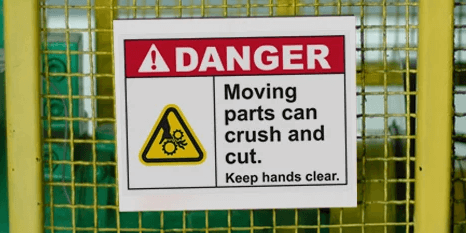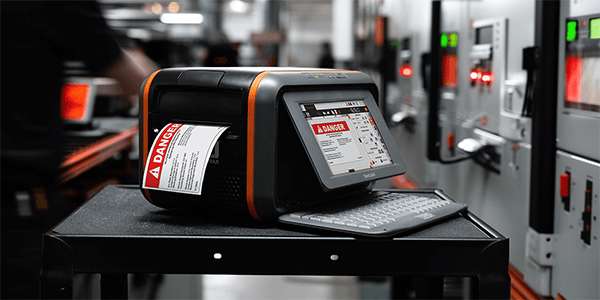Why OSHA Lab Safety Depends on Proper Chemical Labeling Practices

Why Do Pharmaceutical Labs Need Proper OSHA Chemical Labeling?
In the realm of pharmaceutical research and development, maintaining a safe and compliant laboratory environment is paramount. Strong Occupational Safety and Health Administration (OSHA) lab safety practices play a major role in this effort. One crucial aspect of this is ensuring that all hazardous chemicals are correctly labeled according to OSHA regulations.
Using durable lab safety labels and compliant OSHA Hazard Communication (HazCom) labels helps laboratories communicate hazards clearly and consistently. Here is a look at the challenges of safety labeling for laboratories and solutions for permanent container safety labels, secondary container safety labels, replacement container safety labels, and lab safety label regulations.
Laboratory Labeling Challenges in OSHA Lab Safety
Ensuring safety through proper pharmaceutical labeling can present several challenges, particularly in complex environments such as pharmaceutical companies where OSHA lab safety expectations apply.
- Maintaining Label Integrity - Laboratories often deal with extreme temperatures, moisture, and exposure to hazardous chemicals, which can cause lab labels to deteriorate or become illegible. Industrial safety labels—including durable lab safety labels—must withstand handling, spills, and other laboratory conditions without fading or peeling.
- Compliance with Regulations - Keeping up with changing OSHA regulations and standards such as HazCom 2012 can be challenging. Consistent use of OSHA HazCom labels helps laboratories remain compliant. In diverse work environments, labels may also need to be available in multiple languages to support comprehensive OSHA lab safety communication.
-
 Proper Labeling of Secondary Containers - Chemicals are frequently transferred to secondary containers for temporary use. Ensuring these containers are properly labeled, especially if they are used across shifts or by different personnel, is critical. Lab safety labels must remain legible even on small containers where space is limited.
Proper Labeling of Secondary Containers - Chemicals are frequently transferred to secondary containers for temporary use. Ensuring these containers are properly labeled, especially if they are used across shifts or by different personnel, is critical. Lab safety labels must remain legible even on small containers where space is limited. - Consistency in Labeling Practices - Getting all staff members to follow standardized pharmaceutical labeling procedures can be challenging, particularly in large or multi-site laboratories. Ongoing training is necessary so personnel can correctly apply OSHA HazCom labels and understand all labeling requirements.
- Handling Mixed Chemical Waste - Mixed chemical waste often contains multiple hazardous chemicals, requiring comprehensive and clear labeling to communicate all potential hazards.
- Ensuring Label Visibility and Readability – Durable labels must be placed so they are easily visible and readable, which can be challenging in cluttered or compact spaces. Maintaining strong OSHA lab safety practices includes keeping label content clear and easy to identify.
- Integration with Inventory Management Systems – Keeping lab labels consistent with inventory management systems for tracking chemicals can be challenging, particularly when dealing with large inventories and frequent changes. Barcoding or Radio Frequency Identification (RFID) technology can be integrated with labeling systems and applied through customized lab safety labels.
- Chemical Identity and Hazard Communication - Accurately labeling complex chemical mixtures to reflect all hazards can be intricate and requires detailed knowledge of each component. Some chemicals may have evolving or newly discovered hazards, requiring updates to OSHA HazCom labels and other communication materials.
- Label Design and Customization - Designing custom safety labels that meet regulatory requirements and are also practical for laboratory use can be time-consuming and technically challenging. Developing and maintaining standard label templates that can be easily customized for different chemicals and containers is essential but can be complicated.
- Safety Data Sheet (SDS) Integration – Lab labels can include references or links to relevant SDSs to guarantee that these documents are readily accessible to all laboratory personnel. This is a key part of maintaining accurate lab safety labels within a HazCom-aligned program.
Laboratory Pharmaceutical Labeling Requirements for Lab Safety Labels
Permanent Container Safety Labels
OSHA mandates that employers ensure no worker uses, stores, or permits the use or storage of any hazardous chemicals in a laboratory unless the container meets OSHA safety labeling requirements. This applies to all container types, including bags, barrels, bottles, boxes, cans, cylinders, drums, and reaction vessels, as specified in OSHA's Hazard Communication Standard [29 CFR 1910.1200(f)(1)]. These requirements support overall OSHA lab safety procedures. The key requirements are:
- Chemical Identity and Hazard Warnings: Industrial safety labels must clearly state the chemical type and appropriate hazard warnings.
- Primary Health and Physical Hazards: Warning labels must provide primary health and physical hazards using a combination of words, pictures, and symbols.
- Responsible Party Information: The label must include the name and address of the responsible party, such as the manufacturer or importer.
- Legibility and Permanence: Labels must be in English, easily readable, and permanently affixed to the container.
Secondary Container Safety Labels
 Laboratories often require transferring chemicals into secondary containers like bottles, flasks, cans, or beakers. These containers do not require OSHA HazCom labels if the contents are used within a single work shift and remain under the control of the person who made the transfer. However, secondary containers must adhere to the safety labeling requirements if:
Laboratories often require transferring chemicals into secondary containers like bottles, flasks, cans, or beakers. These containers do not require OSHA HazCom labels if the contents are used within a single work shift and remain under the control of the person who made the transfer. However, secondary containers must adhere to the safety labeling requirements if:
- The material is not used within the same work shift.
- The person who made the transfer leaves the work area.
- The container is moved to another work area and is no longer in the possession of the person who filled it.
In these cases, a safety label must identify the hazardous chemicals and the associated hazards, typically through clear lab safety labels with appropriate hazard information.
Best Practice Guide to HazCom 2012 Labeling
Our free HazCom training program will ensure you and your team are fully informed and compliant with the latest safety labeling requirements. This training helps build stronger OSHA lab safety practices throughout the laboratory environment.
Replacement Container Safety Labels
When a container's original safety label needs replacement, the new label must contain the same information as the original and must not be obscured or damaged by the container's contents. DuraLabel offers a wide range of labeling supplies designed to resist moisture, temperature extremes, petroleum products, chemicals, and many solvents, ensuring the durability and legibility of replacement lab safety labels.
Regulations for Lab Safety Labels
OSHA's regulations for Occupational Exposure to Hazardous Chemicals in Laboratories [1910.1450], commonly known as the Laboratory Standard, mandate several safety practices, including proper labeling. Laboratories must develop a Chemical Hygiene Plan (CHP) to protect workers from hazardous chemicals, which includes maintaining accurate safety labels.
Shipping and Receiving: Laboratories producing chemicals for external use must create and maintain labels and safety data sheets and ensure that safety labels on incoming shipments are maintained without alteration or defacement.
Storage: All hazardous chemicals in permanent storage must be clearly labeled with the correct signal words and hazard types.
The Laboratory Standard also references other regulatory standards for specific hazards, such as:
- Hazard Communication Standard (HazCom 2012, 1910.1200)
- Bloodborne Pathogens Standard (1910.1030)
- Formaldehyde Standard (1910.1048)
- Ionizing Radiation Standard (1910.1096)
- Air Contaminants Standard (1910.1000)
How DuraLabel Helps with Lab Safety
Effective pharmaceutical labeling and signage are essential for lab safety, providing vital information about workplace hazards. DuraLabel industrial label and sign printers offer customizable solutions to ensure your custom safety labels meet OSHA regulations. With a variety of printers and over 50 specialty supplies, DuraLabel can help you create clear and compliant visual communications.
Not sure if your lab is OSHA compliant? DuraLabel's Compliance Services can identify potential hazards and ensure your facility meets all OSHA requirements. By partnering with DuraLabel, you can promote a safer workplace, enhance employee awareness, and ensure regulatory compliance in your laboratory.
Read Next:
GHS-HazCom for Medical Facilities
Related Resources

Safety Signs Best Practices for Safer, More Compliant Workplaces
How Does Proper Safety Signage Improve Compliance and Reduce Workplace Risks? Proper safety signs play a ...
Read
Industrial Safety Labels | Label Signage | Sign Label
The accurate interpretation of safety signs is crucial to prevent injuries and save lives. OSHA has set ...
Read
Top 10 Uses for DuraLabel Industrial Label Printers
How DuraLabel Printers are Used Across 10 Key Industrial Applications DuraLabel printers are built to solve ...
Read.png)





